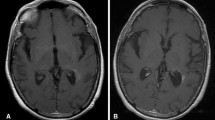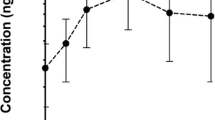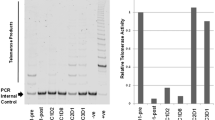Abstract
Backround: Lobradimil is a synthetic bradykinin analog that rapidly and transiently increases the permeability of the blood-brain barrier (BBB). The combination of lobradimil and carboplatin was studied in pediatric patients with primary brain tumors in a phase II trial, the primary endpoints of which were to estimate the response rate and time to disease progression. Patients and methods: Patients were stratified by histology into five cohorts: brainstem glioma, high-grade glioma, low-grade glioma, medullobastoma/primitive neuroectodermal tumor (PNET), and ependymoma. Patients received carboplatin adaptively dosed to achieve a target AUC of 3.5 mg min/ml per day (7 mg·min/ml/cycle) intravenously over 15 min on 2 consecutive days and lobradimil 600 ng/kg ideal body weight/day on 2 consecutive days each 28 day cycle. Results: Forty-one patients, age 2–19 years, were enrolled; 38 patients, including 1 patient ultimately determined to have atypical neurocytoma, were evaluable for response. No objective responses were observed in the brainstem glioma (n=12) and high-grade glioma (n=9) cohorts, although two patients with high-grade glioma had prolonged disease stabilization (>6 months). The study was closed for commercial reasons prior to achieving the accrual goals for the ependymoma (n=8), medulloblastoma/PNET (n=6) and low-grade glioma (n=2) cohorts, although responses were observed in 1 patient with PNET and 2 patients with ependymoma. Conclusion: The combination of lobradimil and carboplatin was inactive in childhood high-grade gliomas and brainstem gliomas.
Similar content being viewed by others
References
Allen J, Walker R, Luks E et al (1987) Carboplatin and recurrent childhood brain tumors J Clin Oncol 5:459–463
Elliott PJ, Hayward NJ, Dean RL et al (1996) Intravenous RMP-7 selectively increases uptake of carboplatin into rat brain tumors Cancer Res 56:3998–4005
Ford J, Osborn C, Barton T et al (1998) A phase I study of intravenous RMP-7 with carboplatin in patients with progression of malignant glioma Eur J Cancer 34:1807–1811
Friedman H, Krischer P, Oakes W et al (1992) Treatment of children with progressive or recurrent brain tumors with carboplatin or iproplatin: a Pediatric Oncology Group randomized phase II study J Clin Oncol 10:249–256
Gaynon P, Ettinger L, Baum E et al (1990) Carboplatin in childhood brain tumors: a Children’s Cancer Study Group phase II trial Cancer 66:2465–2469
Gregor A, Lind M, Newman H et al (1999) Phase II studies of RMP-7 and carboplatin in the treatment of recurrent high grade glioma J Neurooncol 44:137–145
Inamura T, Nomura T, Bartus RT et al (1994) Intracarotid infusion of RMP-7, a bradykinin analog: a method for selective drug delivery to brain tumors J Neurosurg 81:752–758
Marina N, Rodman J, Shema S et al (1993) Phase I study of escalating targeted doses of carboplatin combined with ifosfamide and etoposide in children with relapsed solid tumors J Clin Oncol 11:554–560
Matsukado K, Inamura T, Nakano S et al (1996) Enhanced tumor uptake of carboplatin and survival in glioma-bearing rats by intracarotid infusion of bradykinin analog, RMP-7 Neurosurgery 39:125–133
Prados M, Schold S, Fine H et al (2003) A randomized, double-blind, placebo-controlled, phase 2 study of RMP-7 in combination with carboplatin administered intravenously for the treatment of recurrent malignant glioma Neuro-Oncol 5:96–103
Rapoport SI, Robinson PJ (1986) Tight-junctional modification as the basis of osmotic opening of the blood-brain barrier Ann N Y Acad Sci 481:250–267
Raymond JJ, Robertson DM, Dinsdale HB (1986) Pharmacological modification of bradykinin induced breakdown of the blood-brain barrier Can J Physiol Pharmacol 13:214–220
Simon R, (1989) Optimal two-stage designs for phase II clinical trials Controlled Clin Trials 10:1–10
Warren KE, Patel MC, Aikin AA et al (2001) Phase I trial of lobradimil (RMP-7) and carboplatin in children with brain tumors Cancer Chemother Pharmacol. 48:275–282
Acknowledgments
This research was supported in part by the Intramural Research Program of the NIH, NCI. A complete listing of grant support for research conducted by CCG and POG before initiation of the COG grant in 2003 is available online at http://www.childrensoncologygroup.org/admin/grantinfo.html
Author information
Authors and Affiliations
Corresponding author
Rights and permissions
About this article
Cite this article
Warren, K., Jakacki, R., Widemann, B. et al. Phase II trial of intravenous lobradimil and carboplatin in childhood brain tumors: a report from the Children’s Oncology Group. Cancer Chemother Pharmacol 58, 343–347 (2006). https://doi.org/10.1007/s00280-005-0172-7
Received:
Accepted:
Published:
Issue Date:
DOI: https://doi.org/10.1007/s00280-005-0172-7




